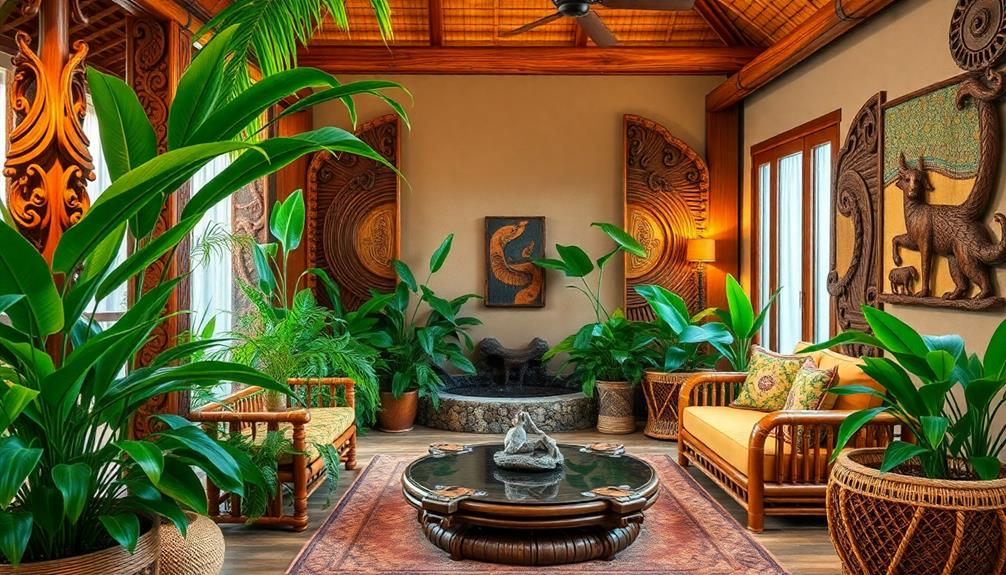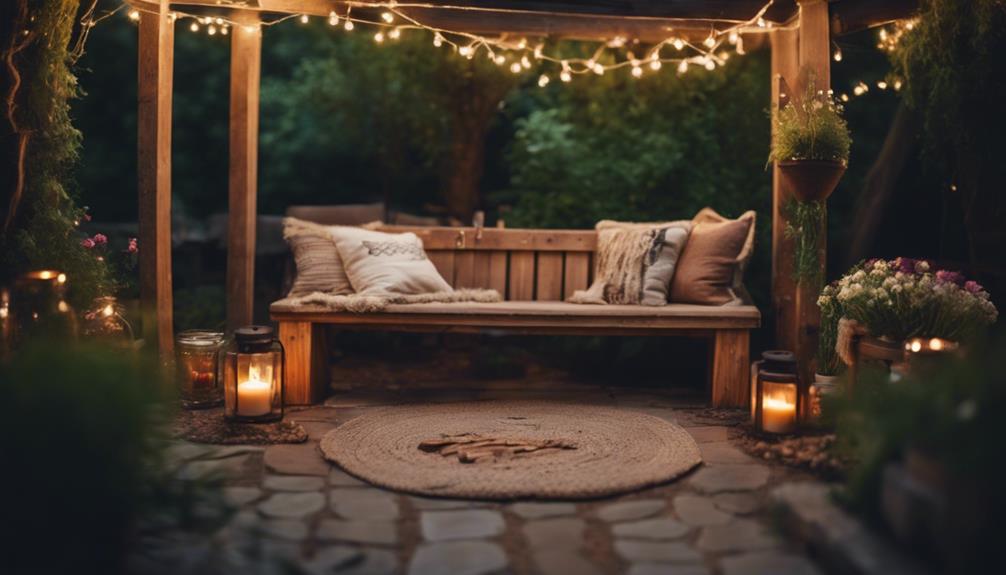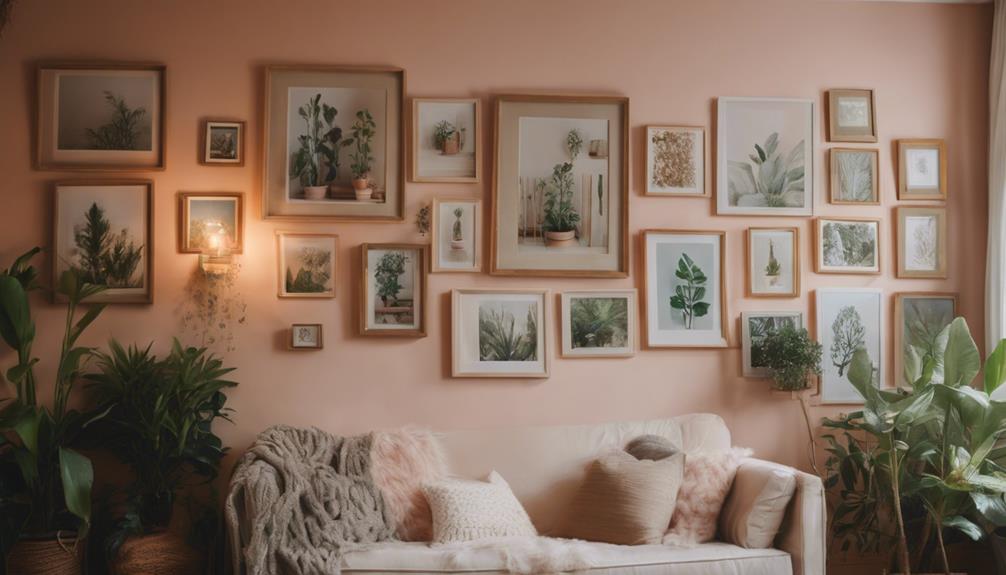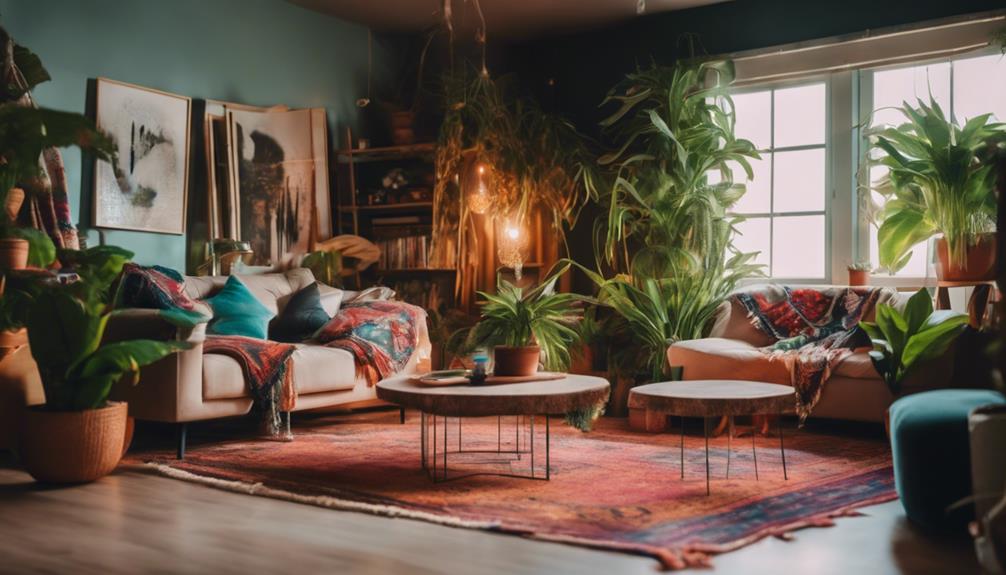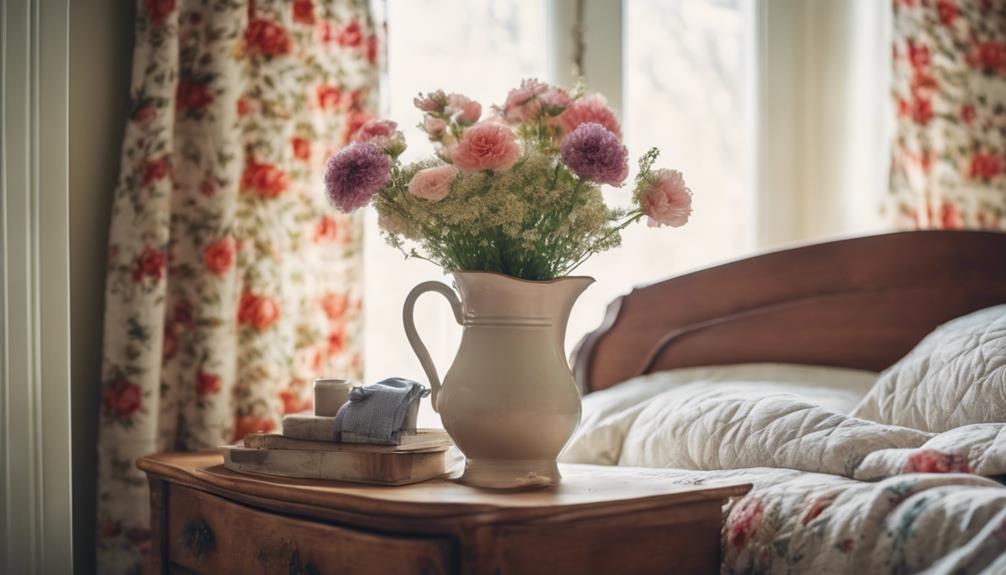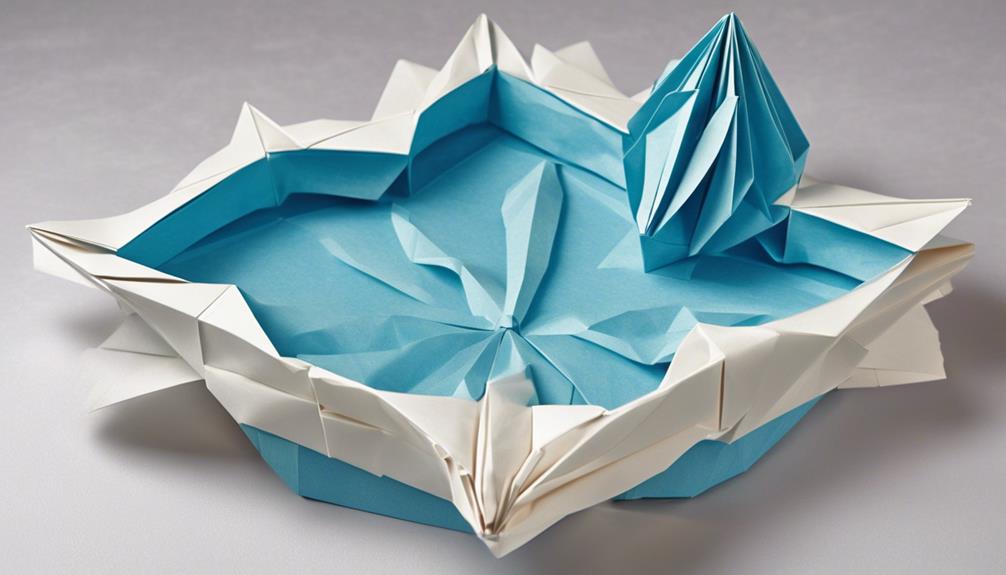You can turn your home into an exotic oasis with Indonesian interior design by embracing tropical architecture and natural materials. Start by creating open layouts that integrate indoor and outdoor spaces using expansive windows. Incorporate luxurious elements like intricately carved teak furniture and bold, vibrant colors. Add lush greenery and calming water features to enhance tranquility. Don't forget cozy seating areas for relaxation. By celebrating Indonesian craftsmanship and sustainable practices, your home will reflect a serene and inviting atmosphere. Explore how to build this unique retreat further to inspire your transformation!
Key Takeaways
- Embrace tropical modern architecture by integrating indoor and outdoor spaces with expansive windows and open floor plans for natural light.
- Utilize locally sourced materials like teak, bamboo, and stone, showcasing Balinese craftsmanship through intricate carvings in furniture and decor.
- Design outdoor living spaces with dedicated zones for dining and lounging, incorporating pergolas, outdoor kitchens, and calming water features.
- Create luxurious bedrooms with private terraces and tropical courtyards, enhancing comfort with vibrant textiles and local decorative elements.
- Incorporate sustainable practices by selecting native plants, using reclaimed materials, and implementing eco-friendly water and energy solutions for a harmonious environment.
Tropical Architecture and Design Principles
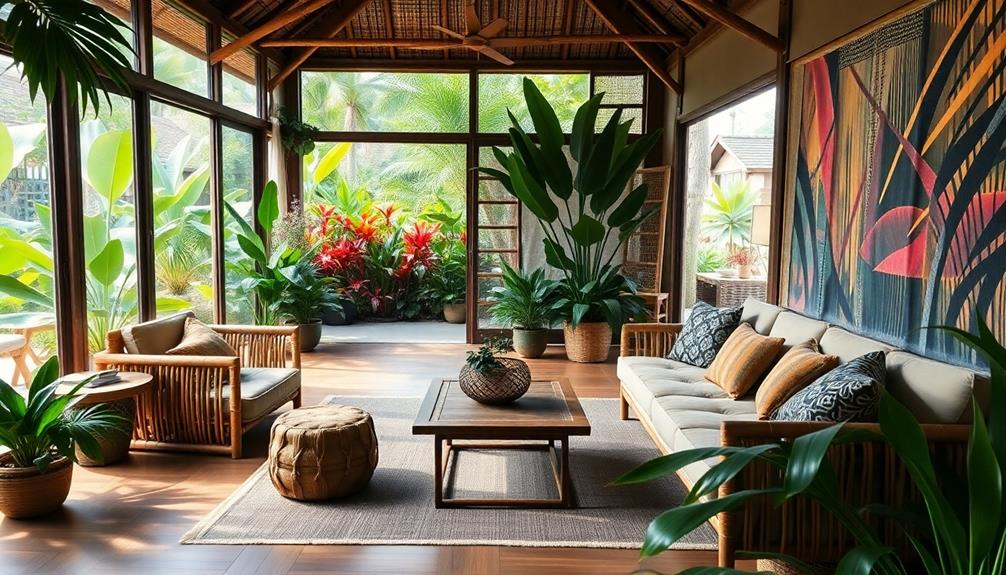
When you embrace Tropical Modern Architecture, you're not just designing a home; you're creating a seamless connection with nature. This approach focuses on blending indoor and outdoor spaces, allowing your living areas to flow effortlessly into the surrounding landscape. Expansive windows and open floor plans are key features, inviting the tropical environment inside and guaranteeing you feel connected to the beauty around you.
Incorporating elements from Mahallati Interiors guarantees that high-quality materials and serene aesthetics reflect the local culture. Using natural materials like locally sourced timber, stone, and thatch, your home will reflect a harmonious aesthetic that resonates with the region's culture. Incorporating elements of Balinese craftsmanship, such as intricate carvings and decorative motifs, adds a unique touch that celebrates local artistry.
Sustainability is also a crucial principle in tropical architecture and design. By selecting native plants, you'll not only enhance your landscape but also reduce water consumption, promoting a more eco-friendly lifestyle.
Don't forget the importance of outdoor living spaces! Designing areas for dining, relaxing, and entertaining under shaded pergolas or around cozy fire pits elevates your home's functionality and enjoyment throughout the year.
Embrace these principles, and you'll create an exotic oasis that truly embodies the spirit of tropical living.
Luxurious Interior Design Elements
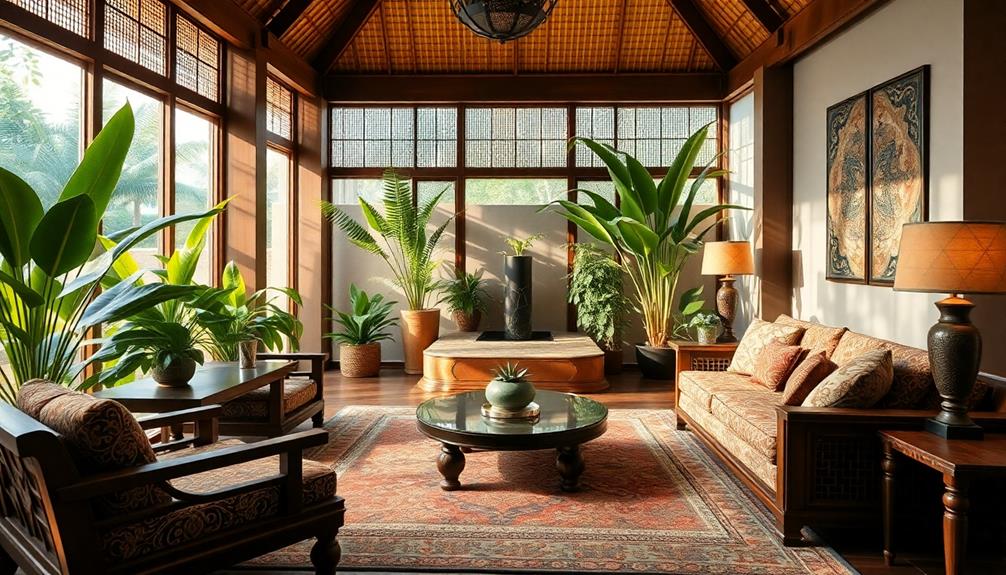
Luxury in Indonesian interior design is all about embracing cultural richness and natural beauty.
You can create an exotic oasis at home by incorporating elements that reflect the region's heritage and vibrant landscapes. To achieve a balanced and harmonious environment, you might also contemplate Balinese design characteristics that blend traditional craftsmanship with modern aesthetics.
Here are four luxurious design elements to contemplate:
- Exotic Wood Accents: Use materials like teak and mahogany to add warmth and elegance. These woods not only enhance the aesthetic but also celebrate local craftsmanship.
- Intricate Carvings: Invest in furniture with detailed carvings inspired by traditional Balinese artistry. These pieces serve as stunning focal points, showcasing meticulous workmanship and unique character.
- Bold Color Palette: Embrace an eclectic mix of colors reminiscent of tropical landscapes. This energizing palette can transform your space into an inviting environment that celebrates nature's beauty.
- Open and Airy Layouts: Opt for open concept designs that promote seamless flow and connectivity. This layout maximizes natural light and offers breathtaking views of surrounding lush landscapes.
Creating Outdoor Living Spaces
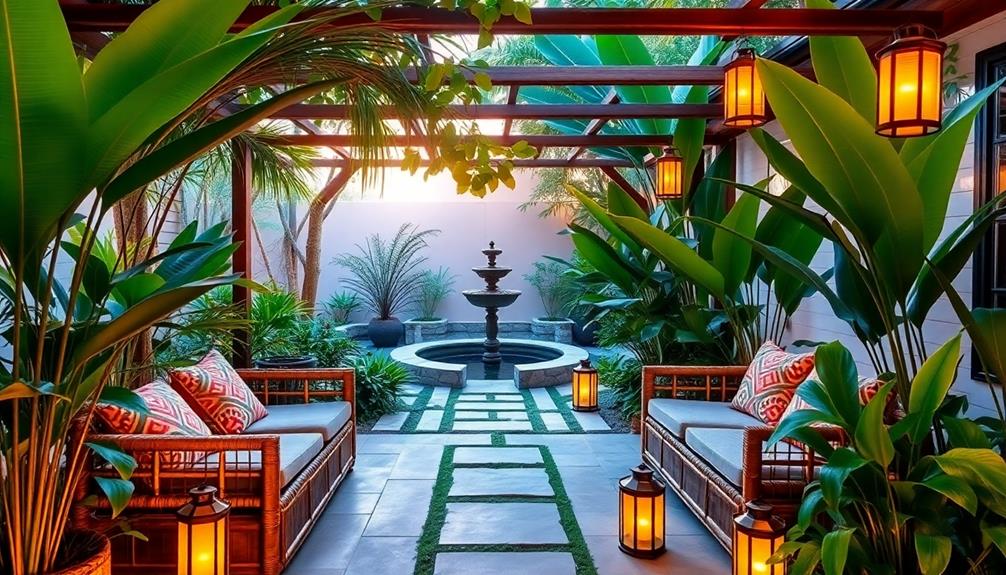
Creating outdoor living spaces can transform your home into an inviting retreat, perfect for enjoying Indonesia's stunning tropical climate. Start by incorporating pergolas or awnings, which provide essential shade and shelter, making your outdoor areas comfortable.
Emphasizing seamless indoor-outdoor flow is key to enhancing your space, allowing you to embrace the natural environment while enjoying the comforts of home. Design dedicated zones for dining and lounging that encourage alfresco experiences. Choose rattan furniture and colorful textiles that reflect local aesthetics, creating a vibrant atmosphere.
To boost functionality, consider adding outdoor kitchens or barbecues, allowing you to entertain effortlessly amidst lush landscapes. For nighttime gatherings, install fire pits or outdoor fireplaces. These features offer warmth and serve as a cozy focal point for social interactions.
Don't forget the importance of water features, such as ponds or fountains. They not only enhance the aesthetic appeal of your outdoor living spaces but also promote relaxation and tranquility.
Additionally, make sure your spaces benefit from natural ventilation, allowing cool breezes to flow through while keeping the environment comfortable. Incorporating tropical villa plans can further elevate your outdoor design, creating a serene atmosphere that invites peace and connection with nature.
Designing Tropical Retreats
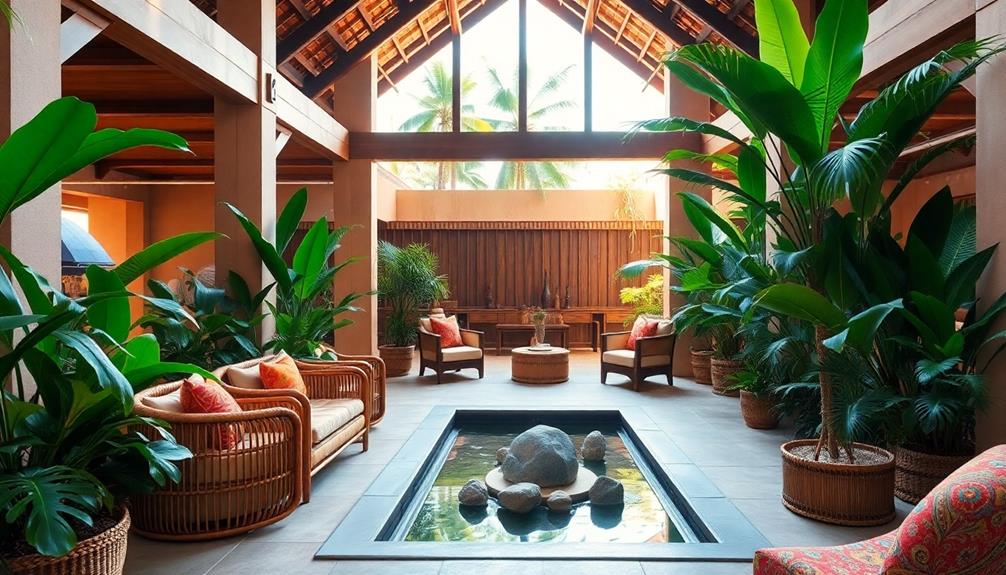
Designing a tropical retreat invites you to escape the hustle and bustle of everyday life, immersing yourself in nature's beauty. By focusing on seamless integration of indoor and outdoor spaces, you can create a sanctuary that truly embodies relaxation and comfort.
Incorporating elements such as Indonesian decorative pillows with vibrant colors and intricate patterns can enhance your living spaces, adding both comfort and cultural heritage. Here are four essential elements to reflect upon:
- Natural Light: Use expansive glass windows to invite abundant sunlight and provide uninterrupted views of the lush surroundings. This connection to nature enhances your sense of tranquility.
- Natural Materials: Incorporate local materials like bamboo, stone, and reclaimed wood to reflect the culture and authenticity of your space. These choices also promote sustainability.
- Luxurious Bedrooms: Design your bedroom as a personal sanctuary with sumptuous bed covers and private terraces, creating a luxurious experience that encourages relaxation.
- Tropical Courtyard Oasis: Create serene outdoor spaces with lush greenery and tranquil water features. Incorporate inviting seating areas and amenities like outdoor kitchens for enhanced functionality.
Crafting Bathroom Escapes
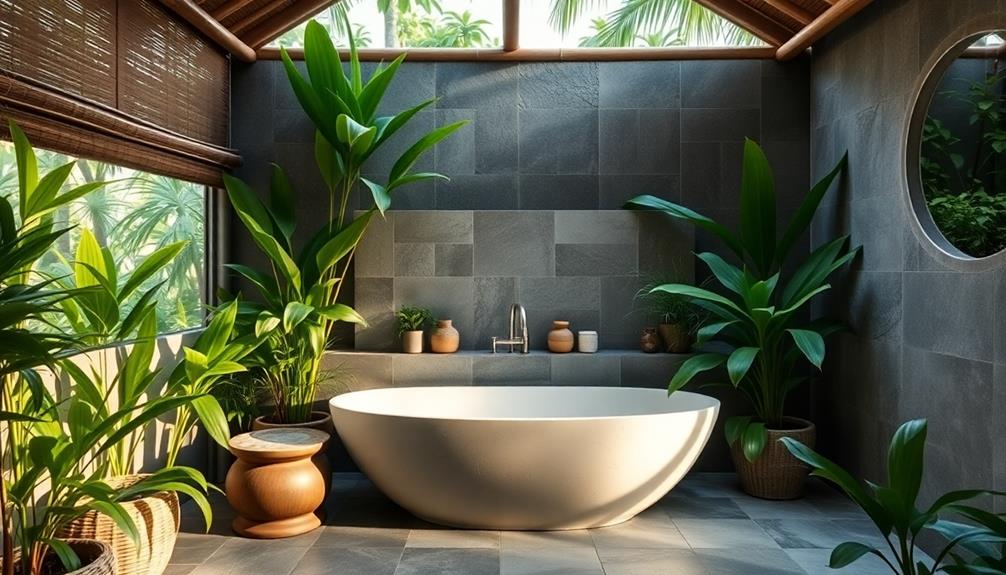
When you're crafting your bathroom escape, think about integrating natural materials like stone and wood for that authentic Indonesian feel.
Emphasizing harmony with nature can help create a tranquil atmosphere, while incorporating traditional textiles adds a touch of local culture.
Incorporating handcrafted elements, such as locally sourced sinks or carved accents, adds artistry and cultural depth to your space.
With these choices, you'll create a serene retreat that enhances both beauty and functionality.
Artistry in Design
In the heart of your home, a tropical bathroom escape can become a sanctuary that reflects the artistry of Indonesian craftsmanship. By embracing handcrafted furniture and fixtures, you create a space that showcases unique artisanal pieces, inspired by Nature.
These elements enhance your bathroom's character while providing visual interest. Consider incorporating these key features:
- Handcrafted Vanities: Choose vanities made from reclaimed wood, showcasing local artisans' skills, particularly those that highlight traditional artistry in their design.
- Natural Stone Finishes: Opt for smooth stones that evoke a sense of tranquility and connection to the earth.
- Open Layouts: Design with large windows or glass doors to frame lush views, allowing natural light to flow in, enhancing the serene atmosphere.
- Local Artwork: Integrate intricate decorative motifs or wall hangings that celebrate Indonesian heritage and creativity.
These elements not only elevate the aesthetic appeal of your bathroom but also transform everyday routines into indulgent rituals.
Natural Material Integration
Creating a tropical bathroom escape involves more than just aesthetic choices; it's about integrating natural materials that evoke warmth and comfort. Start with bamboo, stone, and reclaimed wood to build a welcoming atmosphere, enhancing your connection to nature.
Adding unique decor elements like Indonesian decor masks can further enrich the aesthetic, reflecting rich cultural heritage while supporting local artisans. Handcrafted furniture and artisanal elements not only reflect local craftsmanship but also add character to your space while supporting sustainable practices.
Maximizing natural light is essential, so consider large windows or skylights. This design choice allows you to enjoy views of outdoor greenery, blurring the lines between your indoor retreat and the natural world.
To promote a soothing ambiance, incorporate water features like indoor fountains or stone basins. These elements introduce tranquil sounds, transforming your bathroom into a spa-like haven.
Lastly, prioritize eco-friendly materials and fixtures. Opt for low-flow toilets and faucets to maintain sustainability without sacrificing luxury.
Building a Courtyard Oasis
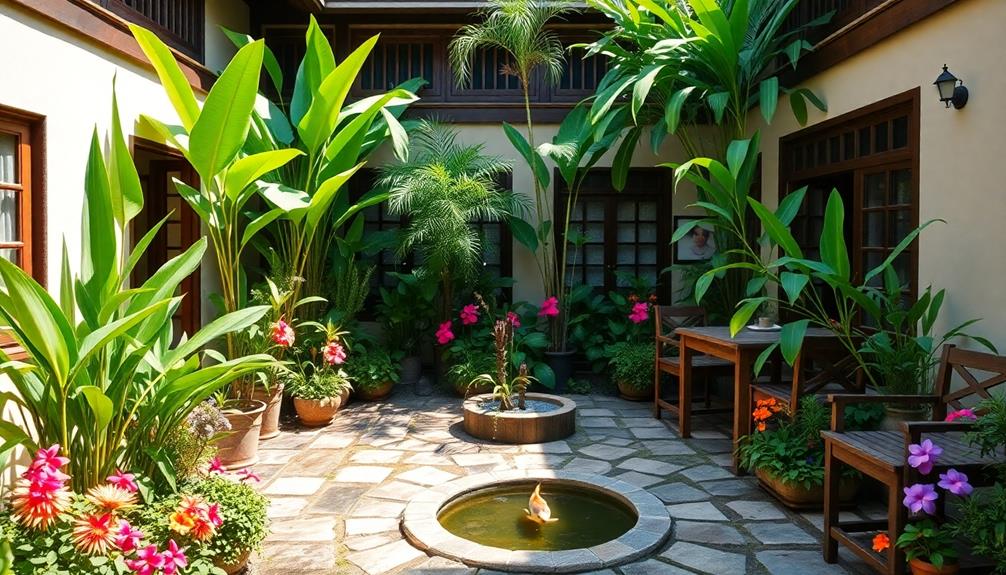
Creating your courtyard oasis starts with selecting lush greenery that brings life and color to your space.
Incorporating traditional Indonesian elements, such as bamboo or thatch structures, can enhance the authenticity of your retreat and connect it to traditional Indonesian housing.
Integrate a calming water feature to enhance the atmosphere and attract local wildlife, while cozy seating arrangements invite you to relax and enjoy the tranquility.
With these elements, your courtyard can transform into a serene retreat right at home.
Lush Greenery Selection
Transforming your outdoor space into a lush courtyard oasis relies on carefully selecting a variety of native plants. This lush greenery selection not only creates a sense of tropical paradise but also minimizes water usage and maintenance efforts, reflecting the diverse architectural styles found in traditional Indonesian housing.
To achieve the perfect balance, consider these four key elements:
- Frangipani – Its fragrant blooms will enhance the sensory experience of your oasis.
- Hibiscus – Vibrant flowers add color and attract pollinators, enriching your garden's ecosystem.
- Bamboo – This fast-growing plant provides privacy and a unique visual appeal, ideal for vertical spaces.
- Vertical Gardens – Design allows you to maximize the available area, offering diverse plant selections without compromising ground space.
Incorporating shade-providing structures like pergolas or thatched roofs will create comfortable lounging areas while protecting your plants from harsh sun exposure.
Additionally, outdoor lighting can highlight the beauty of your lush greenery and transform your courtyard into a serene retreat after dark.
With thoughtful planning, your courtyard can become a mesmerizing oasis, inviting both relaxation and connection with nature.
Water Feature Integration
Incorporating a water feature into your tropical courtyard oasis often elevates the overall ambiance, making it a serene retreat. A pond or waterfall can serve as a stunning focal point, enhancing the landscape design and promoting tranquility. The gentle sound of flowing water from fountains or streams masks ambient noise, creating a more private and inviting space.
To maximize the beauty and functionality of your water feature, consider these essential design elements:
| Feature Type | Benefits | Material Suggestions |
|---|---|---|
| Pond | Supports local wildlife, enhances biodiversity | Natural stone, eco-friendly materials |
| Waterfall | Creates soothing sounds, visual appeal | Bamboo, stone |
| Lighting | Enhances ambiance at night, creates a magical atmosphere | LED lights, lanterns |
Surround your water feature with native aquatic plants to add beauty while maintaining water quality. This integration not only beautifies your oasis but also fosters sustainability. Whether you're hosting evening gatherings or enjoying a moment of quiet reflection, a well-designed water feature will transform your outdoor space into a tranquil haven.
Cozy Seating Arrangements
A cozy courtyard oasis invites you to unwind and connect with nature, making thoughtful seating arrangements essential. By creating inviting spaces, you'll encourage relaxation and social interaction among family and friends.
To enhance your oasis further, consider incorporating elements of Indonesian culture, such as vibrant color palettes and natural materials, which can infuse your courtyard with life and energy. Here are four ideas to elevate your courtyard:
- Low Seating: Incorporate comfortable rattan sofas and floor cushions to promote a laid-back atmosphere that encourages gathering.
- Natural Materials: Use bamboo and teak for your furniture to guarantee durability while enhancing the tropical aesthetic of your oasis.
- Central Feature: Design your seating around a focal point, like a fire pit or water fountain, to foster community and draw attention to your courtyard's beauty.
- Vibrant Textiles: Add vibrant throw pillows and outdoor rugs to reflect the lively colors of your surroundings, introducing texture and warmth to your cozy seating arrangements.
Don't forget about shade! Incorporate pergolas or umbrellas over your seating areas to keep the space comfortable during sunny days and create a cozy atmosphere for evening gatherings.
Embrace the essence of nature while enjoying the vibrant colors and natural materials that make your courtyard a true oasis.
Embracing Sustainable Practices
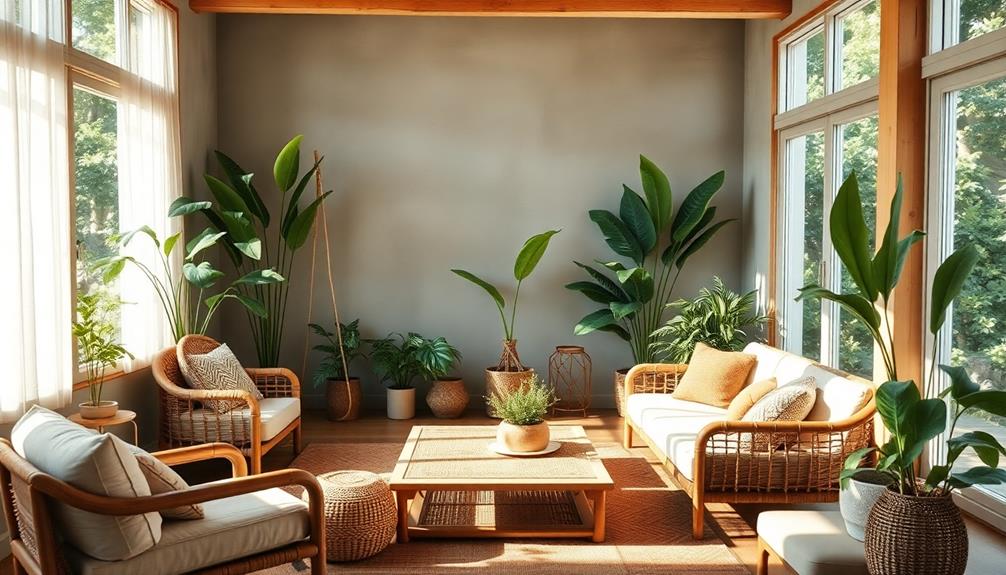
Sustainable practices in Indonesian interior design not only enhance aesthetic appeal but also foster a healthier environment. By incorporating native plants that require minimal water, you promote biodiversity and reduce maintenance costs, making your space both beautiful and low-maintenance.
Implementing rainwater harvesting systems can considerably decrease your water consumption for irrigation and indoor use, aligning perfectly with eco-friendly living principles.
Think about utilizing recycled materials in your furniture and decor. This approach minimizes waste, while adding unique character and history to your interior spaces.
Additionally, you can cut down on energy consumption by incorporating solar lighting and energy-efficient appliances, which helps lower your carbon footprint at home.
Prioritizing reclaimed or sustainably sourced wood in your construction and furnishings not only contributes to a beautiful aesthetic but also supports local economies. By choosing local materials, you help foster community growth while showcasing the rich culture of Indonesia.
Embracing these sustainable practices allows you to create an exotic oasis that reflects your commitment to the environment and enhances your living space's beauty.
Utilizing Natural Materials
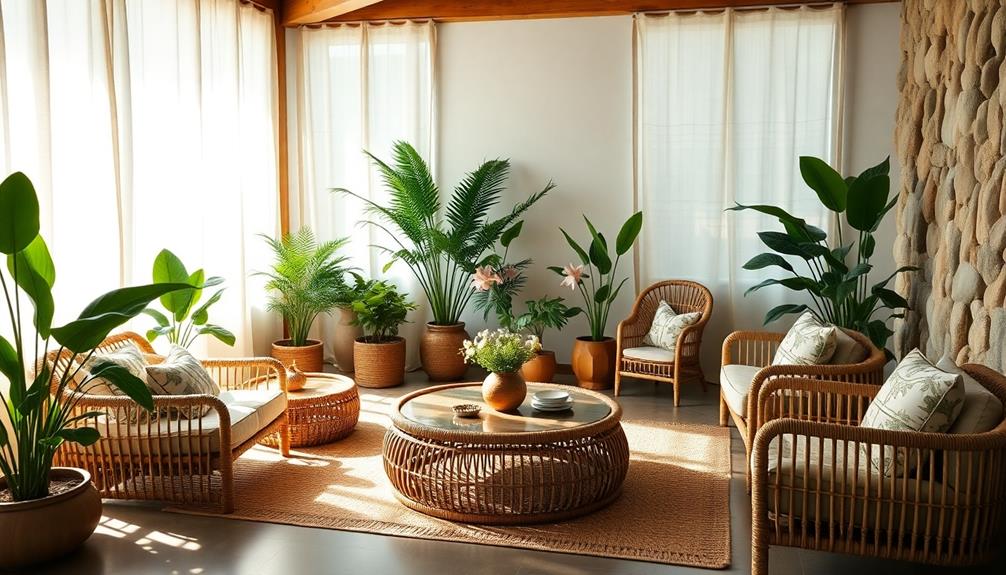
Natural materials play a pivotal role in enhancing the aesthetic and functional qualities of Indonesian interior design. By incorporating elements like reclaimed wood, bamboo, and stone, you can create a harmonious living space that celebrates the beauty of the tropical environment.
These materials foster a deeper connection to nature while adding warmth and character to your home.
Here are four natural materials to contemplate:
- Reclaimed Wood: Adds authenticity and rich texture, showcasing unique wood grain variations.
- Bamboo: An eco-friendly choice, bamboo's versatility allows for stylish furniture and decor.
- Rattan: Incorporating rattan in furnishings promotes a warm, inviting atmosphere while being sustainable.
- Stone: Using stone for flooring or accent walls not only regulates indoor temperatures but also enriches your space with natural textures.
Planning Your Design Project
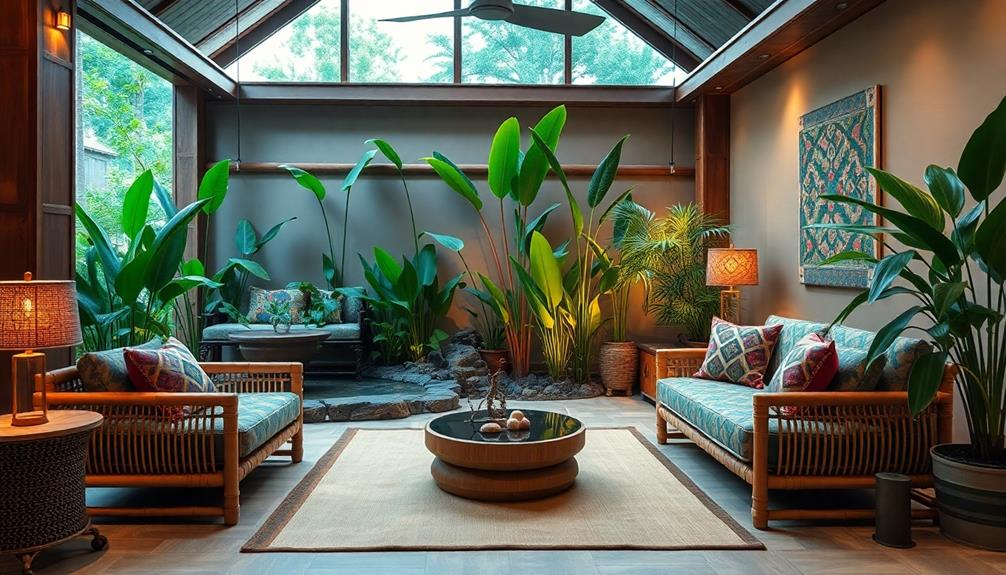
When you commence planning your design project, it's vital to start with a clear budget that reflects your priorities. Distinguish between fundamental features and luxury items to guarantee a well-planned investment. Knowing what you can afford helps you make informed decisions.
Next, research local regulations and permits. Understanding zoning and building codes in your area will help you avoid legal complications down the line. Compliance is significant for a smooth project.
Consider whether to enlist professional help for complex tasks like architectural design or landscaping. While some aspects might be manageable as DIY efforts, evaluating your skills can save you costs and headaches.
Don't forget to assess the long-term maintenance costs associated with your design choices. Opt for materials and features that require minimal upkeep or replacement over time. This foresight can save you money and effort in the future.
Lastly, plan for seasonal considerations by selecting plants that provide year-round interest. Incorporate features like retractable awnings or outdoor heating elements to enhance comfort throughout the year.
With careful planning, your design project can become the exotic oasis you envision.
Frequently Asked Questions
What Are the Best Color Schemes for Indonesian Interior Design?
When choosing color schemes for Indonesian interior design, consider earthy tones like terracotta, rich greens, and warm browns. These colors create a calming atmosphere, reflecting nature while adding vibrancy and warmth to your space.
How Can I Incorporate Indonesian Textiles Into My Home Decor?
You can incorporate Indonesian textiles by adding batik cushions, sarong throws, or woven rugs to your space. Layer these pieces with natural materials and neutral colors to create a harmonious, inviting atmosphere that reflects your style.
What Plants Are Ideal for an Indonesian-Inspired Interior?
Imagine stepping into a lush paradise; incorporating plants like bamboo, ferns, and orchids can transform your space. They thrive indoors, bringing vibrant color and a tropical feel that instantly elevates your interior design.
How Do I Choose Authentic Indonesian Furniture Pieces?
To choose authentic Indonesian furniture, look for handcrafted pieces made from local materials like teak or rattan. Check for intricate carvings and traditional designs that reflect the rich cultural heritage of Indonesia. Trust your instincts!
What Lighting Options Enhance the Indonesian Design Aesthetic?
Imagine stepping into a warm, inviting space. To enhance the Indonesian design aesthetic, consider soft pendant lights, bamboo lanterns, or warm-toned sconces. These options create a cozy ambiance, drawing attention to your beautiful decor.
Conclusion
Incorporating Indonesian interior design ideas can transform your home into a tropical treasure. By blending bold bamboo, vibrant vegetation, and serene spaces, you'll craft an enchanting sanctuary that whispers relaxation. Embrace natural nuances, celebrate sustainable solutions, and create cozy corners for connection. With thoughtful touches and a splash of exotic elegance, your oasis awaits. Immerse yourself in design, and let your imagination flourish in this vibrant venture, where every detail delights and every moment matters.
